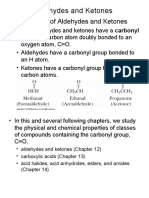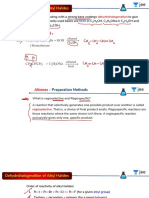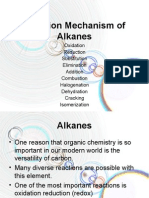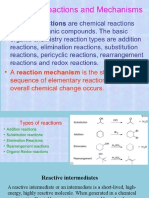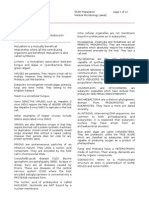Adisi
Adisi
Uploaded by
azizgagabCopyright:
Available Formats
Adisi
Adisi
Uploaded by
azizgagabOriginal Description:
Copyright
Available Formats
Share this document
Did you find this document useful?
Is this content inappropriate?
Copyright:
Available Formats
Adisi
Adisi
Uploaded by
azizgagabCopyright:
Available Formats
ADDITION REACTION
Electrophilic
addition
Radical
addition
Addition
nucleophilic
Concerted
addition
mechanism
Addition of
Hydrogen Halides
to Alkenes
Acid-Catalyzed
Hydration
Addition of
Halogens
Addition Reactions
Involving Epoxides
Electrophilic
Additions Involving
Metal Ions
Reactions of
Alkylboranes
Additions to
Alkynes
Bersifat regioselektif (an unsymmetrical alkene gives a
predominance of one of the two isomeric addition
products)
Berlaku aturan Markovnikov
The addition of hydrogen halide is initiated by protonation
of the alkene
Kereaktifan : HI > HBr > HCl
Kemungkinan terdapat produk sebagai hasil penataan
ulang karbokation
Penataan Ulang karbokation
4-chloro-2,2-dimethylbutane
The regioselectivity of addition of HBr to alkenes can
be complicated if a free-radical chain addition
occurs in competition with the ionic addition.
The free-radical chain reaction is readily initiated by
peroxidic impurities or by light
It leads to the anti Markovnikov addition product.
Conditions that minimize the competing radical
addition:
use of high-purity alkene and solvent
exclusion of light
addition of a radical inhibitor
the presence of silica / alumina (as an adsorbents),
HBr undergoes exclusively ionic addition
Rate = k [alkene][HX]
2
The stereochemistry of addition of HX to
unconjugated alkenes is usually anti.
Temperature and solvent can modify the
stereochemistry (anti-product at near room
temperature and syn-product at 78 C)
adisi syn
The 1,2-addition product results from
Markovnikov addition of HBr across two
adjacent carbon atoms (C
1
and C
2
) of the
diene
The 1,4-addition product results from
addition of HBr to the two end carbons
(C1 and C4) of the diene.
1,4-Addition = conjugate addition
The amount of 1,2- and 1,4-addition products formed in
electrophilic addition reactions of conjugated dienes
depends greatly on the reaction conditions.
Katalis asam yg sering digunakan H
2
SO
4
Berlaku aturan Markovnikov
Mekanisme reaksi diawali pembentukan
karbokation
Berlaku penataan ulang karbokation
Adanya aromatis dan alkil yang menstabilan
karbokation akan menambah kecepatan reaksi
Alkenes
HydrationElectrophilic Addition of Water
Adisi anti
Mekanisme : melalui pembentukan intermediate ion
bromonium yang berjembatan
The order of reactivity is F
2
> Cl
2
> Br
2
> I
2
.
Fluorination is strongly exothermic and difficult to control, whereas for
iodine the reaction is easily reversible
Because this reaction involves formation of charged intermediates, it is
strongly solvent dependent
H
3
C CH
3
C
3
H
7
C
2
H
5
Br
Br
(S) (R)
H
3
C CH
3
C
3
H
7
C
2
H
5
Br
Br
Br
(R)
(R)
H
3
C
CH
3
C
3
H
7
C
2
H
5
Br
Br
(R) (S)
H
3
C
CH
3
C
3
H
7
C
2
H
5
Br
Br
Br
Br
(R)
(R)
H
3
C
CH
3
C
3
H
7
C
2
H
5
Br
Br
(S)
(S)
H
3
C
CH
3
C
3
H
7
C
2
H
5
Br
Br
enantiomers
enantiomers
S,S
S,S
R,R
R,R
Only two compounds (R,R and S,S) formed in
equal amounts. Racemic mixture.
Bromide ion
attacked the
carbon on the
right.
But can
also attack
the left-
side
carbon.
Alternatively, the bromine
ion could have come in
from the bottom!
Attack of the Bromide Ion
(S) (R)
H
3
C CH
3
C
3
H
7
C
2
H
5
Br
Br
(S)
(S)
H
3
C
CH
3
C
3
H
7
C
2
H
5
Br
Br
Starts as R
Becomes
S
The carbon was originally R with the Br
on the top-side. It became S when the
Br was removed and a Br attached to
the bottom.
In order to
preserve a
tetrahedral
carbon these
two
substituents
must move
upwards.
Inversion.
Example of Anti-addition reaction
Halogenation can give 1,2- or 1,4-
addition products from conjugated
dienes.
Bromination is often stereospecifically
: anti for the 1,2-addition process,
whereas syn addition for 1,4-addition.
Chlorination show much less
stereospecificity.
The most widely used reagents for conversion of
alkenes to epoxides are peroxycarboxylic acids
All of the peroxycarboxylic acids are potentially
explosive materials and require careful handling
The reaction rate is not very sensitive to solvent
polarity
Stereospecific syn addition is consistently
observed
The rate of epoxidation is increased by alkyl
groups and other EDG substituents in alkene
structure, and the reactivity of the peroxy acids is
increased by EWG substituents
Ring opening of epoxides can be carried out under
either acidic or basic condition
Base-catalyzed reactions : the nucleophile provides the
breaking the epoxide bond at the less-substituted
carbon, since this is the position most accessible to
nucleophilic attack (steric factor dominates)
Acid-catalyzed reactions : The bonding of a proton to
the oxygen weakens the CO bonds and facilitates
rupture of the ring by weak nucleophiles. This results
from the ability of the more-substituted carbon to
stabilize the developing positive charge (electronic
factor dominates).
Certain metal cations promote addition by electrophilic
attack on alkenes.
Addition is completed when a nucleophile adds to the
alkene-cation complex.
The nucleophile may be the solvent or a ligand from the
metal ions coordination
The best characterized of this reaction involves Hg
2+
as
the cation and the usual nucleophile is the solvent.
The adducts can be isolated as halide salts, but in
synthetic applications the mercury is often replaced by
hydrogen (oxymercuration reduction)
Mechanism
1
2
3
4
The reactivity of different alkenes is governed by a
combination of steric and electronic factors
The addition of the nucleophile follows
Markovnikovs rule
Terminal alkenes are usually more than 99%
regioselective and disubstituted alkenes show
significant regioselectivity which is enhanced by
steric effects
Oxymercuration is usually a stereospecific anti
addition
In contrast to the anti addition observed
with acyclic and monocyclic alkenes,
bicyclic alkenes frequently show syn
addition
Borane is an electron-deficient molecule
and in its pure form exists as a
hydrogen-bridged dimer
Hydroboration is highly regioselective,
with boron becoming bonded to the less-
substituted carbon
The overall transformations occur by syn
addition with anti-Markovnikov
regiochemistry.
Borane eventually reacts with three alkene molecules to
give a trialkylborane.
The second and third alkyl groups encounter severe steric
repulsion if the boron is added at the internal carbon.
Since only one BH bond is needed for
hydroboration, commercially available
dialkylboranes having the general structure
R
2
BH are sometimes used instead of BH
3
.
Example :
The most widely used reaction of
organoboranes is the oxidation to alcohols
ADDITIONS
TO ALKYNES
BASIC
MECHANISM
Mechanism A involves a discrete vinyl
cation. In general, this reaction will lead to
a mixture of the two stereoisomeric
addition products.
Mechanisms B and C depict bridged
intermediates formed without (B) or with
(C) participation of a second electrophilic
molecule. Mechanisms B and C should
lead to anti addition.
Mechanism D is a termolecular process
that would be expected to be a
stereospecific anti addition.
Hydrohalogenation
Hydration
Halogenation
Mercuration
ADDITIONS
TO ALKYNES
HCl, HBr, and HI add to alkynes to form
vinyl halides.
For terminal alkynes, Markovnikov product
is formed.
If two moles of HX is added, product is a
geminal dihalide.
CH
3
C C H
CH
3
C CH
2
Br
HBr
HBr
CH
3
C CH
3
Br
Br
Anti-Markovnikov product is formed with a
terminal alkyne.
HBr
CH
3
C C
H
H
H
Br
Br
ROOR
CH
3
C C H
CH
3
C C
H
H
Br
HBr
ROOR
mixture of E and Z isomers
Mercuric sulfate in aqueous sulfuric acid
adds H-OH to one p bond with a
Markovnikov orientation, forming a vinyl
alcohol (enol) that rearranges to a ketone.
Cl
2
and Br
2
add to alkynes to form vinyl dihalides.
Difficult to stop the reaction at dihalide.
CH
3
C C CH
3
Br
2 CH
3
C
Br
C
Br
CH
3
+
CH
3
C
Br
C
CH
3
Br
Br
2
CH
3
C
Br
Br
C
Br
Br
CH
3
Mercuric ion (Hg
2+
) is electrophile.
Vinyl carbocation forms on most-sub. C.
Water is the nucleophile.
CH
3
C C H CH
3
C
+
C
Hg
+
H
Hg
+2
H
2
O
CH
3
C
H
Hg
+
C
O
+
H H
H
2
O CH
3
C
H
Hg
+
C
OH
H
3
O
+
CH
3
C
H
H
C
OH
an enol
Enol to Keto (in Acid)
Add H
+
to the C=C double bond.
Remove H
+
from OH of the enol.
CH
3
C C
OH
H
H
H
H
2
O
CH
3
C C
O
H
H
H
CH
3
C
H
H
C
OH
H
3
O
+
CH
3
C C
OH
H
H
H
A methyl ketone
Addition of Hydrogen Halides to Double
Bonds
Addition of Halomethanes
Addition of Other Carbon Radicals
Addition of Thiols and Thiocarboxylic Acids
A radical is an intermediate
with a single unpaired electron
Classification of radical
Structure of radical: trigonal
planar geometry
Stability of radical
Formation of radical
formed by homolytic cleavage of
covalent bonds using:
Light ( h); Heat (); Radical Initiators
(ROOR )
A few radicals are stable:
The addition of HBr to alkenes in the presence of heat, light or
peroxides proceeds via a radical mechanism
The regioselectivity of the addition to unsymmetrical alkenes is
different from that in addition of HBr in the absence of heat, light
or peroxides
HBr adds to alkenes under radical conditions, but HCl and HI do
not. This can be explained by considering the energetics of the
reactions using bond dissociation energies.
Both propagation steps for HBr addition are exothermic, so
propagation is exothermic (energetically favorable) overall.
For addition of HCl or HI, one of the chain propagating steps is
quite endothermic, and thus too difficult to be part of a repeating
chain mechanism.
REDUCTION
HYDRATION
ADDITION
OF
ALCOHOLS
ADDITION
OF
CYANIDE
ADDITION
OF
DERIVATIVES
OF
AMMONIA
ADDITION
OF
ORGANO
METALLIC
REAGENTS
ADDITION
OF
ENOLATES
AND
ENOLS
structural features of the
carbonyl compound
the role of protons or other Lewis
acids in activating the carbonyl
group toward nucleophilic attack
the reactivity of the nucleophilic
species
the stability of the tetrahedral
intermediate and the extent to
which it proceeds to product
Metal cations and other Lewis acids can replace
protons as reagents/catalysts for carbonyl addition
reactions.
Acid catalysis involves either protonation or
hydrogen-bonding at the carbonyl oxygen.
Acetals/ cetals are rapidly converted back to
aldehydes / ketones in acidic aqueous solution.
The facile hydrolysis makes acetals / cetals
useful as carbonyl protecting groups
Alkyl substitution decreases the extent of addition.
Aromatic carbonyl compounds are less reactive toward addition than
similar alkyl compounds because the carbonyl group is stabilized by
conjugation with the aromatic ring.
Strong electron-attracting groups favor addition by enhancing the
electrophilicity of the carbonyl group.
Electron donors disfavor addition by stabilizing the aldehyde, whereas
electron-accepting substituents have the opposite effect
Other metals in organometallic reagents are Sn, Si, Tl, Al, Ti, and
Hg. General structures of the three common organometallic
reagents are shown:
Organometallic Reagents
Since both Li and Mg are very electropositive metals,
organolithium (RLi) and organomagnesium (RMgX)
reagents contain very polar carbonmetal bonds and
are therefore very reactive reagents.
Organomagnesium reagents are called Grignard
reagents.
Organocopper reagents (R
2
CuLi), also called
organocuprates, have a less polar carbonmetal bond
and are therefore less reactive. Although they contain
two R groups bonded to Cu, only one R group is utilized
in the reaction.
In organometallic reagents, carbon bears a - charge.
Organolithium and Grignard reagents are typically
prepared by reaction of an alkyl halide with the
corresponding metal.
With lithium, the halogen and metal exchange to form
the organolithium reagent. With Mg, the metal inserts in
the carbonhalogen bond, forming the Grignard
reagent.
Grignard reagents are usually prepared in diethyl ether
(CH
3
CH
2
OCH
2
CH
3
) as solvent.
It is thought that two ether O atoms complex with the Mg
atom, stabilizing the reagent.
Organocuprates are prepared from organolithium
reagents by reaction with a Cu
+
salt, often CuI.
Examples
[1] Reaction of RM with aldehydes and ketones to afford
alcohols
[2] Reaction of RM with carboxylic acid derivatives
[3] Reaction of RM with other electrophilic functional groups
Reaction of Organometallic Reagents with Aldehydes
and Ketones.
Treatment of an aldehyde or ketone with either an
organolithium or Grignard reagent followed by water
forms an alcohol with a new carboncarbon bond.
This reaction is an addition because the elements of R
and H are added across the p bond.
This reaction follows the general mechanism for
nucleophilic additionthat is, nucleophilic attack by a
carbanion followed by protonation.
Mechanism 20.4 is shown using RMgX, but the same
steps occur with RLi reagents and acetylide anions.
Note that these reactions must be carried out under anhydrous
conditions to prevent traces of water from reacting with the
organometallic reagent.
This reaction is used to prepare 1
0
, 2
0
, and 3
0
alcohols.
Li
O
O
-
Li
+
HCl
H
2
O
OH
3,3-Dimethyl-2-
butanone
3,3-Dimethyl-2-phenyl-
2-butanol
(racemic)
+
Phenyl-
lithium
A lithium alkoxide
(racemic)
Aldol Reaction
Claisen Condensation Reaction
Michael Reaction
Stork Enamine Reaction
Robinson Annulation Reaction
One carbonyl partner with
an a hydrogen atom is
converted by base into its
enolate ion
O
C
R
C
H
OH
C
O
C
C
O
R
:
..
..
R
C
O
C
OH
2
C
O
:
: :
Electrophilic
Acceptor
Nucleophilic
Donor
This enolate ion acts as
a nucleophilic donor
and adds to the
electrophilic carbonyl
group of the acceptor
partner
Protonation of the tetrahedral alkoxide ion
intermediate gives the neutral condensation
product.
OH
2
R
C
C
C
OH
-OH
O
+
New C-C Bond
two molecules of an aldehyde or ketone react with
each other in the presence of a base to form a -
hydroxy carbonyl compound
The aldol reaction is a reversible equilibrium
OH is the base typically used in an aldol
reaction.
Aldol reactions can be carried out with either
aldehydes or ketones. With aldehydes, the
equilibrium usually favors products, but with
ketones the equilibrium favors the starting
materials.
72
73
74
Under the basic reaction conditions, the initial aldol product is
often not isolated.
It loses the elements of H
2
O from the a and carbons to form
an a,-unsaturated carbonyl compound.
It may or may not be possible to isolate the -hydroxy carbonyl
compound under the conditions of the aldol reaction. When the
a,-unsaturated carbonyl compound is further conjugated with a
carbon-carbon double bond or a benzene ring, elimination of
H
2
O is spontaneous and the -hydroxy carbonyl compound
cannot be isolated.
75
It is possible to carry out an aldol reaction between two
different carbonyl compounds. Such reactions are called
crossed or mixed aldol reactiontions.
When only one carbonyl
component has a hydrogens,
lead to the formation of only
one product
When one carbonyl
component has especially
acidic a hydrogens, these
hydrogens are more readily
removed and becomes the
enolate component of the
aldol reaction
-Dicarbonyl compounds are sometimes called active
methylene compounds because they are more reactive towards
base than other carbonyl compounds. 1,3-Dinitriles and a-
cyano carbonyl compounds are also active methylene
compounds.
79
Useful Transformations of Aldol Products
Figure 24.3
Conversion of a -hydroxy
carbonyl compound into other
compounds
Aldol reactions with dicarbonyl compounds can be used to
make five-and six-membered ringsThe enolate formed
from one carbonyl group is the nucleophile, and the carbonyl
carbon of the other is the electrophile.
For example, treatment of 2,5-hexadienone with base forms a
five-membered ring.
81
82
Carbonyl condesation that occurs between two
ester components and gives a -keto ester
product
Reaction is reversible and has a mechanism
similar to aldol reaction
Major difference from aldol condensation is the
expulsion of an alkoxide ion from the tetrahedral
intermediate of the initial Claisen adduct
1 equivalent of base is needed to drive the
reaction to completion because the product is
often acidic
CH
3
COEt
O
- OEt
Ethoxide base abstracts
an acidic a hydrogen
atom from an ester
molecule, yielding an
ester enolate ion
:CH
2
COEt
O
EtO
H
CH
3
C
:O:
OEt
+
Nucleophilic donor
Electrophilic
acceptor
In a nucleophilic addition,
this ion adds to a second
ester molecule, giving a
tetrahedral intermediate.
CH
3
C
:O: -
OEt
CH
2
COEt
O
..
The tetrahedral intermediate
is not stable. It expels ethoxide
ion to yield the new carbonyl
compound, ethyl acetoacetate.
CH
3
C
O
CH
2
COEt
O
EtO- +
CH
3
C
O
CHCOEt
O
_
..
EtOH +
Oxide ion is basic enough to convert the -keto
ester product into its enolate, thus shifting the
equilibrium and driving the reaction to
completion
CH
3
C
O
CH
2
COEt
O
OH
2
+
Protonation by addition of acid
in a separate step yields the final
product.
H
3
O+
occurs only when one of the two ester
components has no a-hydrogens, and
thus cant form enolate ion
can also be carried out between esters and
ketones resulting a synthesis of -diketones
1. NaH/THF
+
2. H30
C
O
CH
O
C
H
2
OEt
EtO
Ethyl benzoylacetate
C
O
OEt
Ethyl Benzoate
(Acceptor)
+
CH
O
COEt
3
Ethyl Acetate
(Donor)
can be carried out with diesters
works best on 1, 6-diesters and 1,7-diesters
5-membered cyclic -ketoesters result from
Dieckmann cyclization of 1,6-diesters
6-membered cyclic -keto esters result from
cyclization of 1,7-diesters
O
O
O
C
O
H
OEt
OEt
Diethyl hexanedioate
(a 1,6 -Diester)
1. Na+ -OEt, ethanol
2. H3O+
OEt
EtO
Ethyl 2-oxocyclopentanecarboxylate
(82%)
O
O
O
C
O
OEt
OEt
Diethyl heptanediote
(a 1,7- Diester)
1. Na+ -OEt, ethanol
2. H3O+
OEt
+
Ethyl-2-oxocyclohexane carboxylate
H
O
H
OEt
COOEt
+
OEt Na
-
Base abstracts an
acidic a-proton from
the carbon atom next
to one of the ester
groups, yielding an
enolote ion.
Intramolecular nucleophilic addition of the ester enolate
ion to the carbonyl group of the second ester group at the
other end of the chain then gives a cyclic tetrahedral
intermediate.
O
H
H
tEO
COOEt
+
EtO
:
. .
-
H
O
COOEt
tEO
: :
. .
-
Loss of alkoxide ion from the tetrahedral
intermediate forms a cyclic -keto ester.
O
H
O
.
H
COOEt
+
tEO
:
.
. .
.
-
COOEt
-
EtO
+
Deprotonation of
the acidic -keto
ester gives an
enolate ion
O
H
H
O
+
H
3
O
COOEt
+
2
which is
protonated by
addition of aqueous
acid at the endoth
the reaction to
generate the neutral
-keto ester
product.
The Michael reaction involves two carbonyl componentsthe enolate of one
carbonyl compound and an a,-unsaturated carbonyl compound.
The a,-unsaturated carbonyl component is often called a Michael acceptor.
98
When the product of a Michael reaction is a -keto ester,
it can be hydrolyzed and decarboxylated by heating in
aqueous acid. This forms a 1,5-dicarbonyl compound.
Recall that 1,5-dicarbonyl compounds are starting
materials for intramolecular aldol reactions.
Some
Michael Acceptors and
Michael Donors
H
2
C CHCHO
H
2
C CHCO
2
Et
H
2
C
CHC N
H
2
C CHCOCH
3
H
2
C CHNO
2
H
2
C CHCONH
2
Propenol
Ethyl Propanoate
Propenenitrile
3-Buten-2-one
Nitroethylene
Propenamide
RCOCH2COR'
RCOC
H2CO
2
Et
EtO
2
CCH2CO
2
Et
RCOCH2C N
RCH2NO
2
Beta-Diketone
Beta-Keto Ester
Malonic Ester
Beta-Keto nitrile
Nitro compound
Michael Acceptors Michael Donors
leads to the formation of
substituted cyclohexenones
2 step process:
Michael reaction
Intramolecular Aldol reaction
Treatment of a -diketone or -
keto ester with an a,-unsaturated
ketone leads first to a Michael
addition, which is followed by
intramolecular aldol cyclization
102
The mechanism of the Robinson annulation consists of two
parts: a Michael addition to the a,-unsaturated carbonyl
compound, followed by an intramolecular aldol condensation.
In part two of the mechanism, an intramolecular aldol reaction
is followed by dehydration to form a six-membered ring.
Enamine adds to an a,-unsaturated
carbonyl acceptor in a Michael- type
process
Overall reaction is a three-step
sequence:
Step 1: Enamine formation from a ketone
Step 2: Michael-type addition to an a,-
unsaturated carbonyl compound
Step 3: Enamine Hydrolysis back to ketone
Example
O
N
H
-H
2
O
N
H
2
C
CHCCH
3
O
..
Cyclohexanone An enamine
N
CH
2
CHCCH
3
-
..
O
N
CH
2
CH
2
CCH
3
O
+
OH
2
O
CH
2
CH
2
CCH
3
O
N
H
+
A 1,5-diketone
O
CO
2
Me
O
-
Br
CO
2
Me
+
Mencantumkan 2
contoh reaksi dari
jurnal ilmiah
Ditulis di kertas
tersendiri
Jurnal dilampirkan
Tiap kelompok
mencantumkan reaksi
yg berbeda meski
nama reaksi sama
Kel 1 & 2 : Aldol
Kel 3 & 4 : Claisen
Kel 5 & 6 : Dieckmann
Kel 7 & 8 : Michael
Kel 9 & 10 : Robinson
You might also like
- Learning To Formulate Body Milks and Light LotionsDocument62 pagesLearning To Formulate Body Milks and Light Lotionsnzanella86No ratings yet
- WADE7 Lecture 08Document69 pagesWADE7 Lecture 08panda_bearz95No ratings yet
- 4.2 Hydration of AlkenesDocument33 pages4.2 Hydration of AlkenesDawit BirhanuNo ratings yet
- Organic Chemistry BKF1323: 2.2 AlkenesDocument55 pagesOrganic Chemistry BKF1323: 2.2 Alkenes0JTINGNo ratings yet
- Addition ReactionDocument34 pagesAddition Reactionmichot feleguNo ratings yet
- Ch06 Lecture All PDFDocument89 pagesCh06 Lecture All PDFasyaanazNo ratings yet
- Alkenesandthierpreparation 151207081642 Lva1 App6891Document24 pagesAlkenesandthierpreparation 151207081642 Lva1 App6891Eisha SaleemNo ratings yet
- 32 DR Zhou Lecture 32 PDFDocument23 pages32 DR Zhou Lecture 32 PDFBUCH203No ratings yet
- Organic ReactionsDocument16 pagesOrganic Reactionsyie_793No ratings yet
- Haloalkanes and Haloarenes NotesDocument18 pagesHaloalkanes and Haloarenes NotesAnkitha shajiNo ratings yet
- Alkenes PDFDocument22 pagesAlkenes PDFIsuri VidyarathneNo ratings yet
- Alkyl HalidesDocument27 pagesAlkyl HalidesCATHERINE BAGUIORONo ratings yet
- Alkenes and Alkynes2015Document37 pagesAlkenes and Alkynes2015firouzeh68No ratings yet
- AlkenesDocument16 pagesAlkenesAbhijeetNo ratings yet
- Electrophilic Addition of Alkenes NotesDocument17 pagesElectrophilic Addition of Alkenes NotesAnanda Vijayasarathy100% (1)
- Alkenes and AlkynesDocument22 pagesAlkenes and AlkynesAyodele AdeyonuNo ratings yet
- Structure of Aldehydes and KetonesDocument42 pagesStructure of Aldehydes and KetonesPaul Jhon EugenioNo ratings yet
- AlkenesDocument120 pagesAlkenesVidhan PatniNo ratings yet
- AlkeneDocument11 pagesAlkeneMaria ziaNo ratings yet
- 6) Chapter 8 Alkenes and Alkynes IIDocument44 pages6) Chapter 8 Alkenes and Alkynes IIfarah_affandyNo ratings yet
- 2042 Unit 2_2 (1)Document17 pages2042 Unit 2_2 (1)fasilmengesha79No ratings yet
- Chapter 4 AlkenesDocument40 pagesChapter 4 Alkenesdead soulNo ratings yet
- CHAPTER 6 Alkyl Halides and Aryl HalidesDocument150 pagesCHAPTER 6 Alkyl Halides and Aryl HalidesexpertwritersNo ratings yet
- Oxidation ReactionDocument17 pagesOxidation ReactionIkharRidhoNo ratings yet
- Reaction - Mechanism of AlkanesDocument39 pagesReaction - Mechanism of AlkanesGlen MangaliNo ratings yet
- Chapter 3a (Compatibility Mode)Document71 pagesChapter 3a (Compatibility Mode)HaiNo ratings yet
- Addition Reactions of AlkenesDocument34 pagesAddition Reactions of AlkenesAlvis MwangiNo ratings yet
- Electrophilic Addition of Hydrogen HalidesDocument16 pagesElectrophilic Addition of Hydrogen HalidesDk Hazra HadzryaNo ratings yet
- Unit IV Addition To Carbon Multiple BondsDocument33 pagesUnit IV Addition To Carbon Multiple Bondsamirthalakshmi19751002No ratings yet
- Reactions of AlkenesDocument22 pagesReactions of Alkenesdela2No ratings yet
- Chem 3 - Alkenes Part 2 PDFDocument54 pagesChem 3 - Alkenes Part 2 PDFFeaid Aina OrnedoNo ratings yet
- Haloalkanes and Haloarenes Notes PDFDocument18 pagesHaloalkanes and Haloarenes Notes PDFadib 8083No ratings yet
- Addition Reactions of AlkenesDocument34 pagesAddition Reactions of AlkeneskiokocurtisNo ratings yet
- Organic ReactionsDocument44 pagesOrganic ReactionsJanhavi PatilNo ratings yet
- Alquenos: Parte IDocument31 pagesAlquenos: Parte IJose Kalvin RojasNo ratings yet
- Organic Chemistry,: Radical ReactionsDocument54 pagesOrganic Chemistry,: Radical ReactionsNurul RamadanahNo ratings yet
- OCRMechanisms 2Document8 pagesOCRMechanisms 2Ali AfaqNo ratings yet
- Lec 6C Alkyne Structure and ReactivityDocument37 pagesLec 6C Alkyne Structure and Reactivityseanroi.villas.lawNo ratings yet
- Note Chapter 3 AlkenesDocument48 pagesNote Chapter 3 Alkenesnurin9631No ratings yet
- Halo Alkanes & HaloarenesDocument30 pagesHalo Alkanes & HaloarenesEarNo ratings yet
- Lecture 07: Reactions of AlkenesDocument28 pagesLecture 07: Reactions of AlkenesTon SuphalerkNo ratings yet
- Organic Chemistry Chapter 4Document58 pagesOrganic Chemistry Chapter 4Laiba KhanNo ratings yet
- 5) Preparation of Haloalkanes From Hydrocarbons, Alkenes and Halogen Exchange - RemovedDocument2 pages5) Preparation of Haloalkanes From Hydrocarbons, Alkenes and Halogen Exchange - RemovedMansa KaurNo ratings yet
- Chapter 1_Basic Organic ChemistryDocument53 pagesChapter 1_Basic Organic ChemistryEemesh NarayanaNo ratings yet
- Electrophilicadditionfinal 140313091410 Phpapp02Document39 pagesElectrophilicadditionfinal 140313091410 Phpapp02Abdulrahman SaadNo ratings yet
- Alkynes: An Introduction To Organic SynthesisDocument9 pagesAlkynes: An Introduction To Organic Synthesisggwp21No ratings yet
- All organic mechanismsDocument9 pagesAll organic mechanismsnanaagyemang2006No ratings yet
- Chapter 11 Alkynes: Lecture Notes Chem 51B S. KingDocument12 pagesChapter 11 Alkynes: Lecture Notes Chem 51B S. KingHuấnĐìnhNguyễnNo ratings yet
- Chapter 4 AlkeneDocument64 pagesChapter 4 AlkeneMELVINDO JACOBNo ratings yet
- CH 7 7eDocument42 pagesCH 7 7eVy TranNo ratings yet
- Reaction of AlkenesDocument27 pagesReaction of AlkenesHui JingNo ratings yet
- Organic Chemistry Chapter 8Document41 pagesOrganic Chemistry Chapter 8채종희No ratings yet
- Addition Reactions and Their MechanismsDocument47 pagesAddition Reactions and Their MechanismsttinbddinNo ratings yet
- Lec 8,9,10 Reactions of HydrocarbonsDocument29 pagesLec 8,9,10 Reactions of Hydrocarbonsinushanth inuNo ratings yet
- 3) Rxns of HydrocarbonsDocument31 pages3) Rxns of HydrocarbonsfhdlakNo ratings yet
- ADDITION REACTIONDocument13 pagesADDITION REACTIONgulshanshehzadi444No ratings yet
- Practice Makes Perfect in Chemistry: Acids, Bases, and Salts with AnswersFrom EverandPractice Makes Perfect in Chemistry: Acids, Bases, and Salts with AnswersNo ratings yet
- Advances in Organometallic Chemistry and Catalysis: The Silver / Gold Jubilee International Conference on Organometallic Chemistry Celebratory BookFrom EverandAdvances in Organometallic Chemistry and Catalysis: The Silver / Gold Jubilee International Conference on Organometallic Chemistry Celebratory BookArmando J. L. PombeiroRating: 5 out of 5 stars5/5 (1)
- Alkane FunctionalizationFrom EverandAlkane FunctionalizationArmando J. L. PombeiroNo ratings yet
- Agarwood InductionDocument13 pagesAgarwood Inductiona b100% (1)
- Exam 2c PDFDocument7 pagesExam 2c PDFJosh BakerNo ratings yet
- 5 - - 懶人包 - Production of FertilizerDocument7 pages5 - - 懶人包 - Production of Fertilizer1126playpubgNo ratings yet
- BEP2043 Mass Balance - Group 1 AssignmentDocument11 pagesBEP2043 Mass Balance - Group 1 AssignmentArrianna PeterNo ratings yet
- G5 Fraklin Capstone Chap 1 5 Final PaperDocument37 pagesG5 Fraklin Capstone Chap 1 5 Final PaperCyrelleNo ratings yet
- Fungi and Algae: Chapter # 05 Class: IxDocument2 pagesFungi and Algae: Chapter # 05 Class: IxTanveer AhmedNo ratings yet
- What Happens When Hydrochloric Acid & Sodium Thiosulphate ReactDocument6 pagesWhat Happens When Hydrochloric Acid & Sodium Thiosulphate ReactAzel OthmanNo ratings yet
- Jeffamine ED-600 Polyetheramine: Technical BulletinDocument2 pagesJeffamine ED-600 Polyetheramine: Technical BulletinAnonymous oSf3D0No ratings yet
- Enzymatic Extraction and Clarification of Juice From Various Fruits-A ReviewDocument14 pagesEnzymatic Extraction and Clarification of Juice From Various Fruits-A ReviewyagolainNo ratings yet
- Bioaugmentation and Biostimulation Strategies To Improve The Effectiveness of Bioremediation Processes.Document11 pagesBioaugmentation and Biostimulation Strategies To Improve The Effectiveness of Bioremediation Processes.Dr. mukeshNo ratings yet
- A Virtual Autodesk-Simulink Reference Plant For Wastewater TreatmentDocument11 pagesA Virtual Autodesk-Simulink Reference Plant For Wastewater TreatmentEcheNo ratings yet
- Updated Composite NotesDocument22 pagesUpdated Composite NotesHardeep SinghNo ratings yet
- Microbiology Key NotesDocument12 pagesMicrobiology Key NotesHarini Rajeev LaxminarayanNo ratings yet
- Hydrocarbons Most important questions with answersDocument9 pagesHydrocarbons Most important questions with answerssanjaysanthoshkn2008No ratings yet
- IB Biology - The Origin of CellsDocument4 pagesIB Biology - The Origin of CellsPriyani GuptaNo ratings yet
- Ghee Chemistry: Karuna Meghwal Assistant Professor MIDFT, MehsanaDocument50 pagesGhee Chemistry: Karuna Meghwal Assistant Professor MIDFT, MehsanaNamraNo ratings yet
- Paper Seminar by Avi Raizada: The Plant Cell, Vol. 24: 4437 - 4451Document37 pagesPaper Seminar by Avi Raizada: The Plant Cell, Vol. 24: 4437 - 4451RockyNo ratings yet
- MSIHC RulesDocument61 pagesMSIHC RulesAMAN PRATEEK DaradNo ratings yet
- Safdar 2016Document13 pagesSafdar 2016Tanesh SelvarajuNo ratings yet
- Reductive Pyrolysis Study of Sulfur Compounds in Different Tabas Coal Samples (Iran)Document7 pagesReductive Pyrolysis Study of Sulfur Compounds in Different Tabas Coal Samples (Iran)DadanNo ratings yet
- Metal-Organic Framework Structures Adsorbents For Natural GasDocument54 pagesMetal-Organic Framework Structures Adsorbents For Natural GasMarcos AndréNo ratings yet
- MoPSE Science Module Volume 1 - FINAL4WEBDocument336 pagesMoPSE Science Module Volume 1 - FINAL4WEBSibusiso Ntomby NkalaNo ratings yet
- Saponification of SoapDocument11 pagesSaponification of SoapMsfaeza Hanafi80% (5)
- Hanging by ThreadDocument3 pagesHanging by ThreadFrench Sarah NeraNo ratings yet
- FST 07 Sol (Vvs-Aatp)Document29 pagesFST 07 Sol (Vvs-Aatp)Muk esh.NNo ratings yet
- 6.1 Making Carbohydrates Using Light EnergyDocument19 pages6.1 Making Carbohydrates Using Light EnergyBoliticNo ratings yet
- Connecting The Chemical Industry Together !: A Monthly Magazine Devoted ToDocument78 pagesConnecting The Chemical Industry Together !: A Monthly Magazine Devoted ToPatodia ChemicalsNo ratings yet
- Mescaline CemistryDocument4 pagesMescaline CemistryDevin FordNo ratings yet
- Final Program BookDocument28 pagesFinal Program Bookabdullah farhanNo ratings yet
















